Asus Zenbook S 16 Review: AMD Ryzen AI 300 impresses with stellar performance across the board
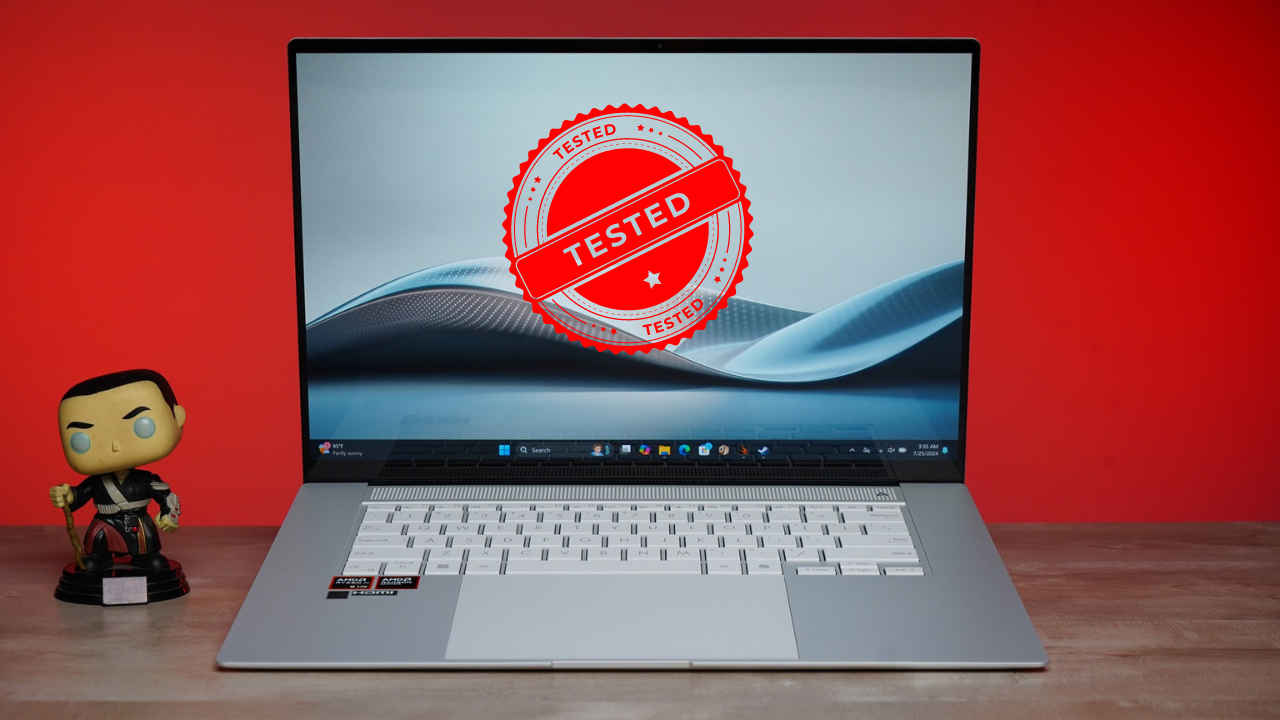
The Asus Zenbook S 16 is a stellar laptop that shines with its exceptional performance, productivity, and battery life, making it an ideal choice for creators and design professionals. The AMD Ryzen AI 300 series platform is the driving force behind this excellence, delivering unparalleled performance and efficiency. While the laptop’s 16-inch form factor may not be the most compact, its lightweight design and gorgeous 3.2K OLED display make it a versatile work-and-play companion. However, we wish the display was brighter to mitigate reflections. The Ryzen AI 300 platform’s impressive performance and efficiency pose a significant challenge to Qualcomm and Intel, especially in AI and graphics performance. With upcoming updates and emerging competition from Intel Lunar Lake and Qualcomm X-Elite, the AI PC market is poised for an intense showdown. Overall, the Asus Zenbook S 16 and Ryzen AI 300 platform combination is a winning duo that sets a high standard for performance, efficiency, and innovation.
The Asus Zenbook S 16 is a special laptop in many ways; it’s one of the slimmest, lightest, and fastest 16-inch thin and light laptops around, and it’s also running on the very latest AMD Zen 5 platform, which was announced at Computex 2024. We’ve covered the platform specifics via our deep-dive features on the all-new AMD XDNA 2 NPU, which is the star of the show as far as the new AMD Zen 5 architecture is concerned. We got a glimpse of the Asus Zenbook S 16 at the AMD Techday 2024 event in Las Vegas earlier this month. The Zenbook S 16 was one of our top picks of what we saw at the AMD Zen 5 Techday. Now that we’ve reviewed it, we can say with confidence that the Asus Zenbook S 16, with the shiny new AMD Ryzen AI 300 platform under its hood, is a delightful combination of performance, design, and efficiency.
This review of the Asus Zenbook S 16 also serves as a platform review of laptops powered by the AMD Ryzen AI 300 series. We have benchmarked and tested the laptops across various parameters, focusing specifically on CPU, NPU, and iGPU performance, as well as the efficiency of the platform to determine the expected battery life of AMD Ryzen AI 300 series-powered laptops. The Zenbook S16 is powered by the AMD Ryzen AI 9 HX370 processor, which is currently the top-of-the-line SoC from the AMD Ryzen AI 300 series processors in the 28W TDP segment. Codenamed Strix Point, the Ryzen AI 9 HX370 processor features 12 cores (four Zen 5 cores and eight Zen 5c cores) and supports 24 threads. It is built on TSMC’s 4nm FinFET process technology. With a maximum boost clock of 5.1 GHz and a base clock of 2.0 GHz, the processor has a default TDP of 28W. The standout feature of the Ryzen AI 300 series is the AMD XDNA 2.0 NPU, which boasts up to 50 TOPS of performance, the highest in the segment to date for standalone NPU performance. Additionally, AMD has enhanced the graphics performance of the iGPU with its RDNA 3.5-based Radeon 890M integrated graphics chip, promising performance levels close to those of entry-level gaming laptops in thin and light laptops. Before we delve into the performance benchmarks, let’s review the specs. Unlike most other reviews, which typically start with build quality, looks, and design, this review will begin with the performance test results and comparison, given the all-new AMD Ryzen AI 300 platform, and later cover the overall laptop review, including design, display performance, thermal performance, and the overall value proposition of the Asus Zenbook S 16.
Asus Zenbook S 16 UM5606WA Specifications:
Processor: AMD Ryzen™ AI 9 HX 370 Processor, 12 cores, 24 Threads
RAM: 32GB LPDDR5X on board, Max Total system memory up to:32GB
Graphics: AMD Radeon 890M Graphics
Display: 16.0-inch, 3K (2880 x 1800) OLED 16:10 aspect ratio
Storage: 1TB M.2 NVMe 4.0 SSD
Battery: 78WHrs
Weight: 1.50 kg
Dimensions: 35.36 x 24.30 x 1.19 cm (13.92″ x 9.57″ x 0.47″)
Color: Scandinavian White
Webcam: FHD camera with IR function to support Windows Hello
Connectivity:
1x USB 3.2 Gen 2 Type-A
2x USB 4.0 Gen 3 Type-C
1x HDMI 2.1
1x 3.5mm Combo Audio Jack
SD 4.0 card reader
Pricing: Rs. 1,55,000 (approximate)
Asus Zenbook S 16: CPU, NPU, and iGPU Performance Analysis and Comparison
We tested the Zenbook S 16 across various industry-standard benchmarks, which assess the CPU, GPU, and AI workload performance, including on-device image generation and computer vision ML performance.
Specifications of Asus Vivobook S 15 and Samsung Galaxy Book Pro 16 in the performance comparison charts below:
Asus Vivobook 15: Snapdragon® X Elite X1E 78 100 Processor 3.4GHz (42MB Cache, up to 3.4GHz, 12 cores, 12 Threads), 16GB LPDDR5X memory on board, 1TB M.2 NVMe PCIe 4.0 SSD, Battery-70WHrs.
Samsung Galaxy Book 4 Pro 16: Intel® Core Ultra 7 Processor 155H, 32 GB LPDDR5X memory on board, 1TB NVMe PCIe 4.0 SSD, Battery- 76WHrs.
CPU Performance and Benchmarks:
The Asus Zenbook S 16 delivered an impressive performance across the board, consistently producing some of the best scores we’ve seen from an x86-based thin and light laptop to date. However, it does exchange blows with the ARM-based Qualcomm Snapdragon X-Elite-based Asus Vivobook 15, particularly in the relatively new Cinebench 2024 benchmark, where the X-Elite surpasses its x86 rivals.
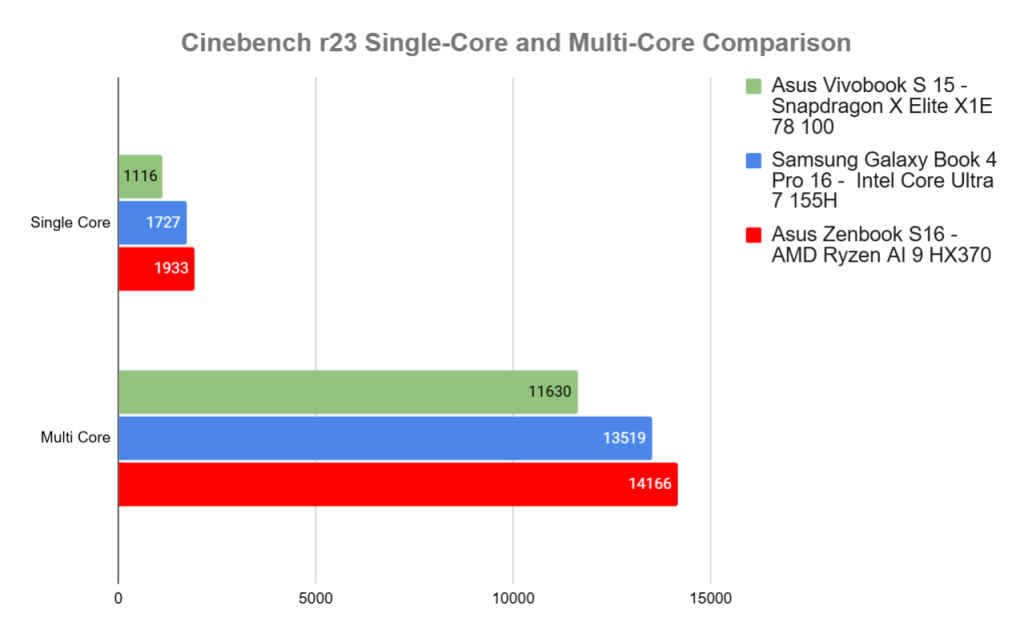
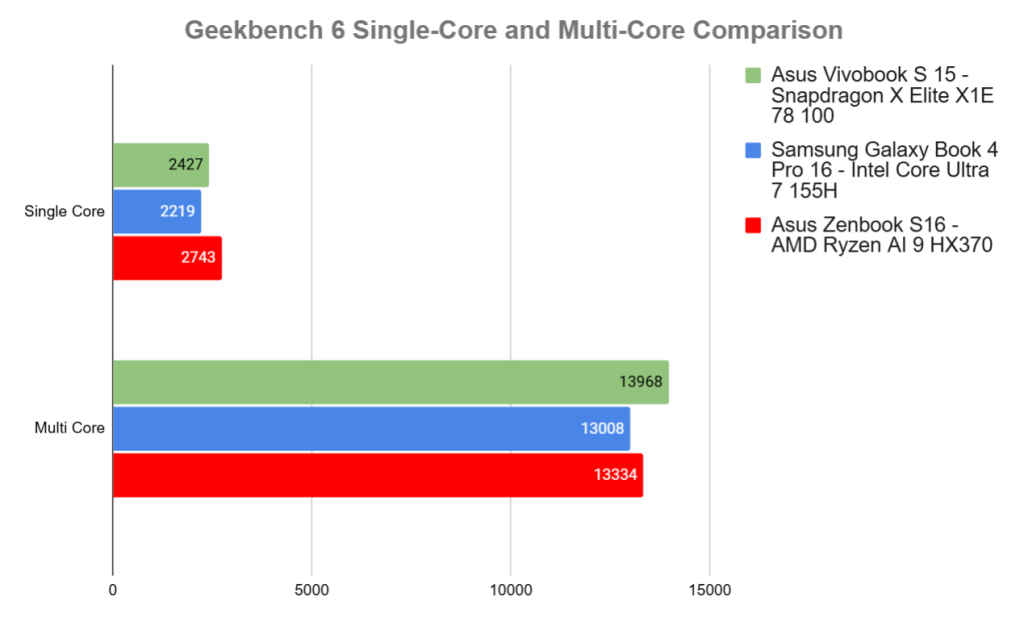
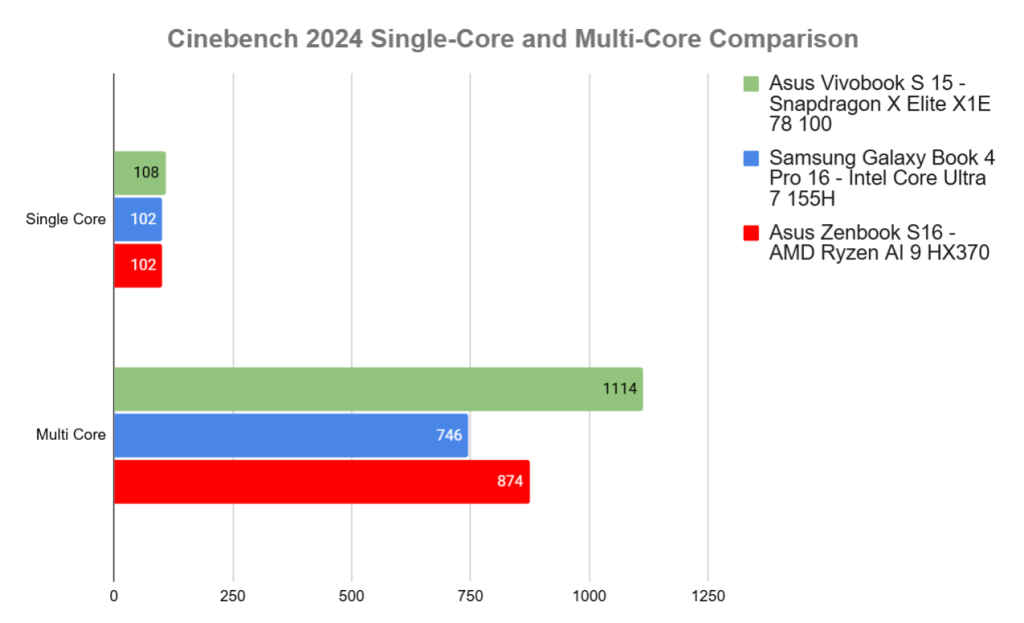
AI performance and benchmarks:
We installed the Procyon Professional Benchmarking Suite and ran the Procyon AI Image Generation Benchmark, which utilizes the Stable Diffusion 1.5 (FP16) model. This benchmark generates 16 images in batches of four and returns a score based on the time taken to produce the images. Additionally, we tested AI performance by running the AI Computer Vision Benchmark, also part of the Procyon Suite.
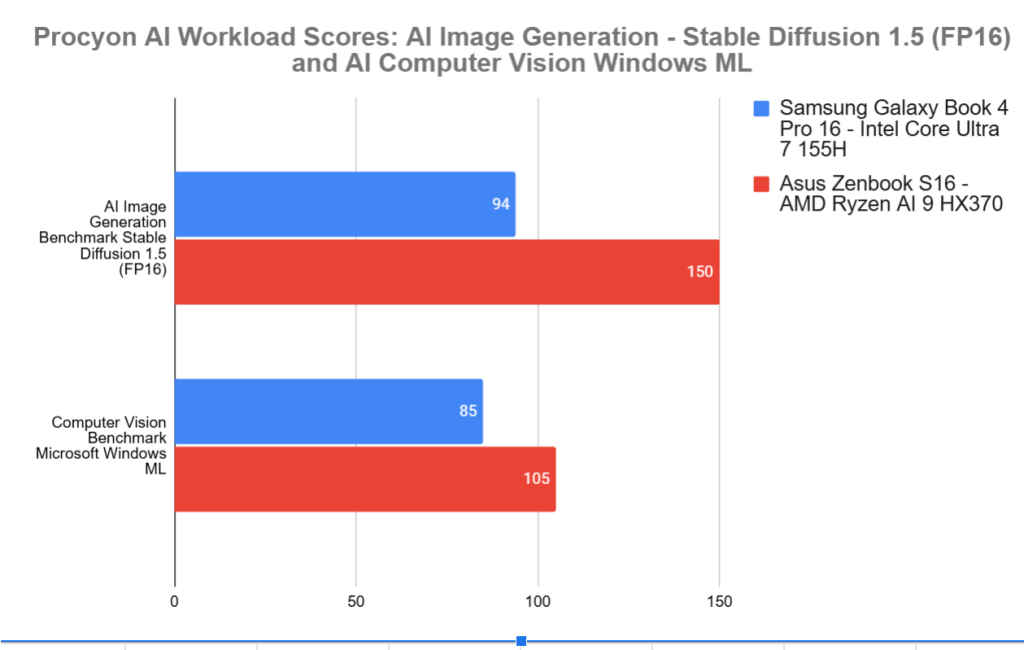
As shown, the AMD Ryzen AI 9 HX370-based Asus Zenbook 16 demonstrates a distinct lead over the Samsung Galaxy Book 4 Pro 16, powered by the Intel Core Ultra 7 155H processor. Despite having comparable power profiles with a base TDP of 28W, the AMD processor excels in graphics performance and benchmarks.
Graphics performance and benchmarks:
To evaluate graphics performance, we conducted a range of synthetic and real-world gaming benchmarks. The results below illustrate the AMD Zen 5 platform’s significant strength in graphics performance, which translates to a notable advantage in both gaming and on-device generative AI workloads. Given that most on-device AI workloads and benchmarks focus on image generation capabilities, the AMD Ryzen AI 9 HX370-based Asus Zenbook 16 exhibits a clear lead in 720p and 1080p gaming across various genres. This performance advantage is also reflected in synthetic benchmarks like 3DMark.
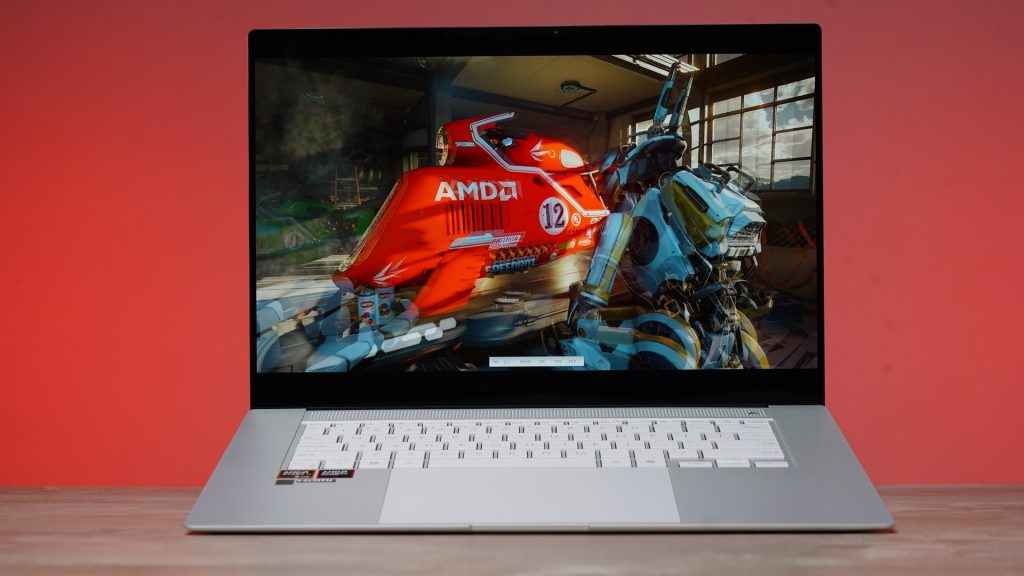

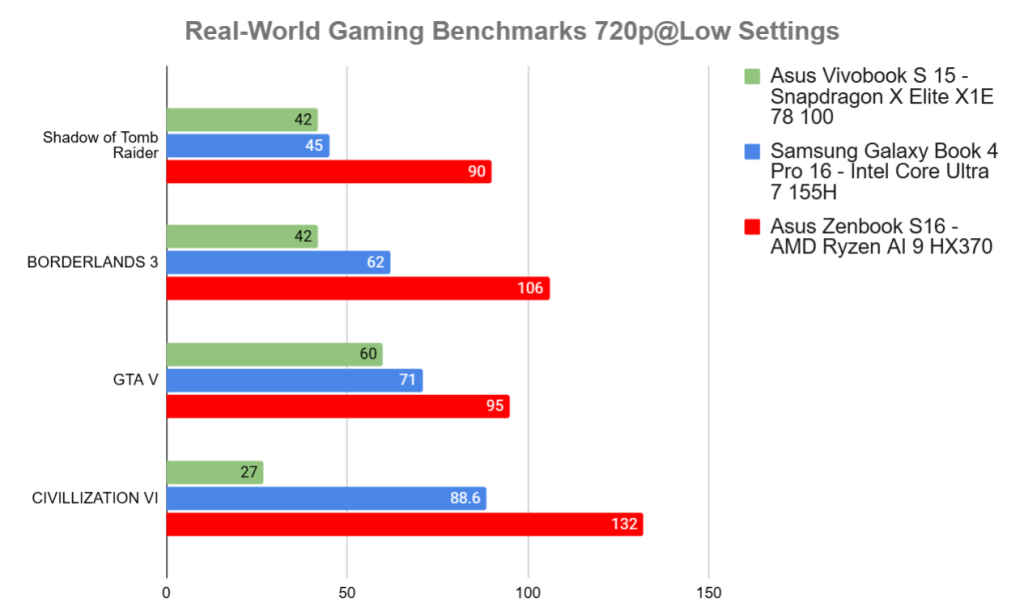
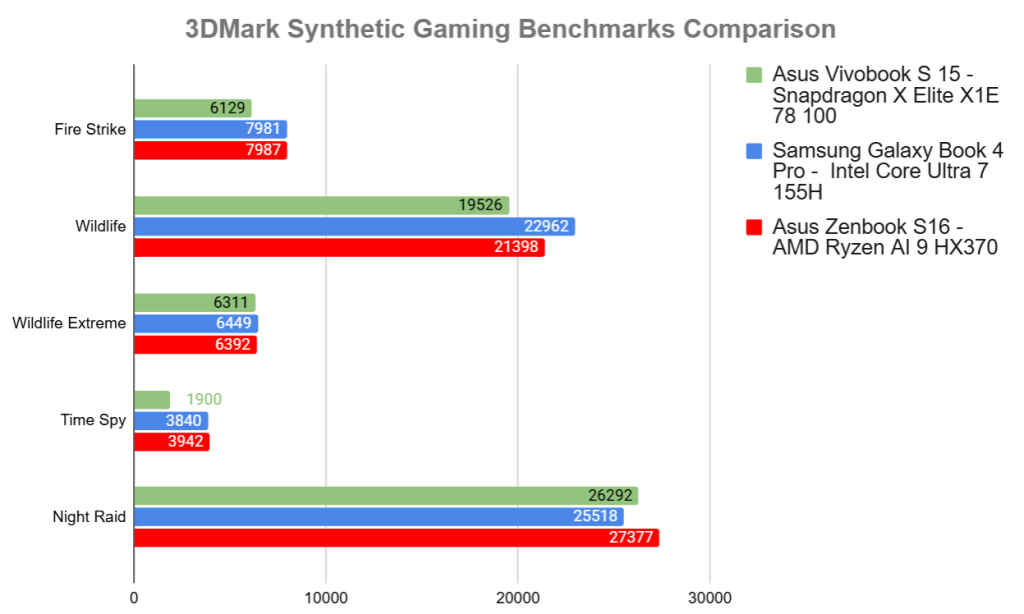
The Asus Zenbook 16 achieves an average of approximately 50FPS at 1080p with medium settings, showcasing the RDNA 3.5’s impressive integrated GPU performance. Whether this can replace an entry-level gaming laptop depends on individual definitions and expectations. While performance numbers approach those of gaming laptops equipped with the Nvidia GeForce RTX 3050 (4GB) in some cases, it’s uncertain whether all real-world gaming performance would be directly comparable. However, the fact that these gaming performance numbers can be achieved while running on battery power (we also tested the laptop on battery) is a significant advantage for AMD and Asus.
Battery Life:
Typically, high performance comes at the cost of battery life, especially when it comes to good gaming performance. However, the Asus Zenbook S 16 defies this convention, offering great battery life alongside impressive iGPU performance. We tested the Zenbook S 16’s battery life using the Procyon Video Playback battery life test, which drains the battery to 5% via a video playback loop test. The Zenbook S 16 delivered 11 hours and 33 minutes of battery life.
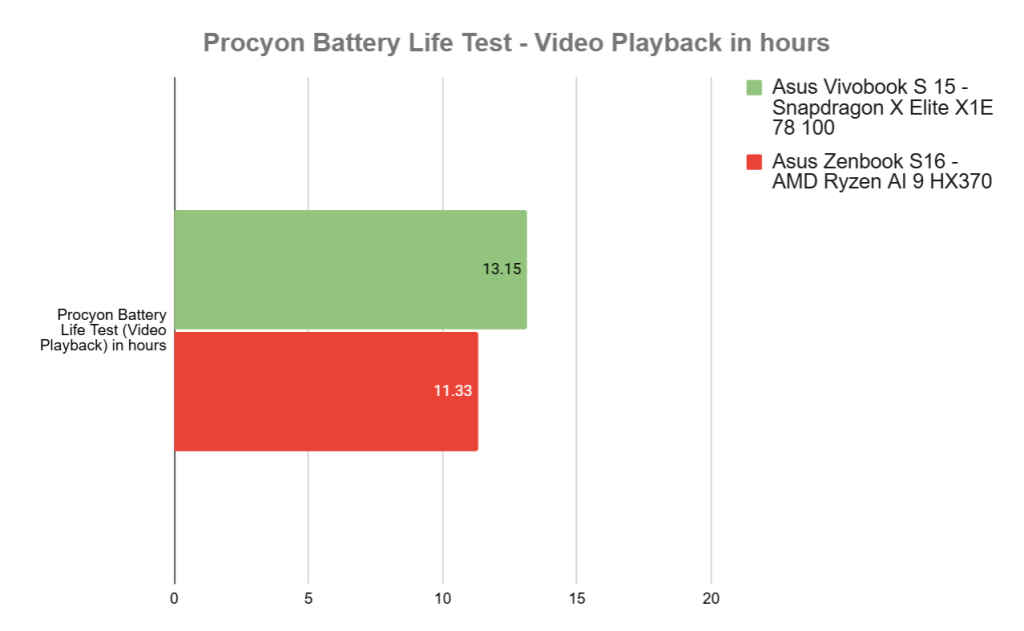
While not the best result we’ve seen, it’s remarkably close to the top performer, the Asus Vivobook S 15, which runs on the Qualcomm Snapdragon X Elite platform. Unfortunately, we couldn’t run the same benchmark on the Samsung Galaxy Book 4 Pro 16 due to persistent crashes, even after a fresh Windows installation. We’ve reported the issue to Procyon and will update the numbers to provide a comparison with the Intel Core Ultra 7-based Samsung Galaxy Book 4 Pro 16. Nonetheless, the battery life of the Asus Zenbook S 16 is impressive and lives up to AMD’s claim of all-day battery life for AMD Ryzen AI 300 series-based laptops.
Design, build quality, and thermal management:
ASUS claims to have pushed the boundaries of laptop design with the Zenbook S 16, and in many ways, it delivers. The most unique aspect of the Zenbook S 16 is the “Ceraluminum” process on the top (lid). The design team at Asus has delivered a unique combination of aluminum and ceramic to create Ceraluminum. The treatment is expected to lend ruggedity and elegance. We like the feel and texture for sure, the smooth matte ceramic-like texture is most certainly very unique and we’d surely like to applaud Asus for strides in material science, especially in the case of the premium thin and light laptop category, where most of them are aluminum slabs with very little innovation or variety when it comes to design and use of unique materials.
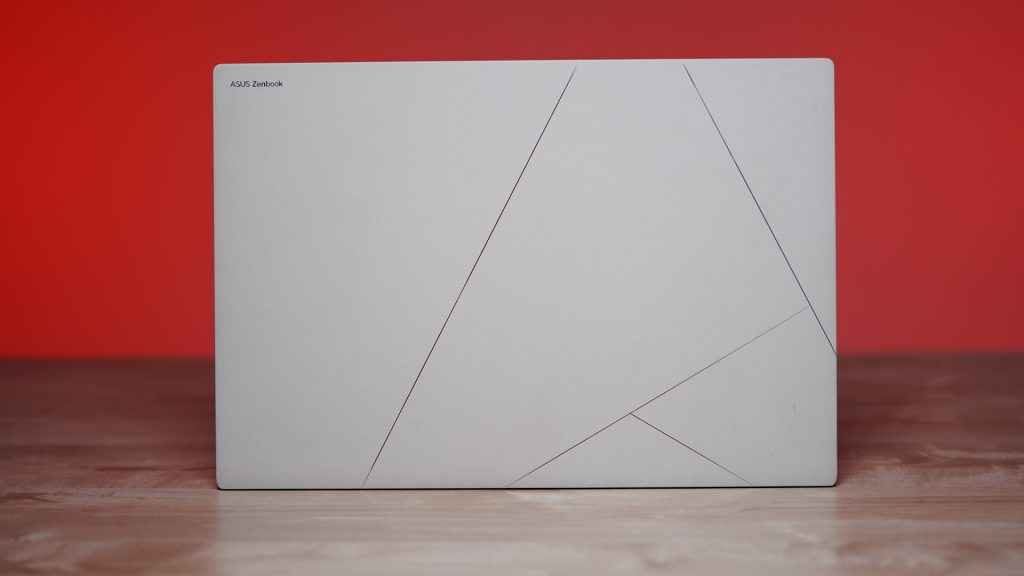
What’s also noteworthy is the geometric grille design on the inside, boasting 3,522 CNC-machined cooling vents that are designed to boost cooling efficiency. The laptop’s svelte form factor, weighing a mere 1.5 kg with a side profile of just 1.1 cm, makes it a portable powerhouse. ASUS also asserts that its ambient cooling system, featuring dual fans and an ultra-slim vapor chamber, enables whisper-quiet operation. Moreover, the company claims this cooling system allows the laptop to reach an optimal 28-watt TDP without throttling, ensuring seamless performance. During our testing, we surely found the Asus Zenbook S 16 to be one of the best when it comes to thermal management, the system never got to uncomfortable levels of heating, even during extensive benchmarking. The heat was managed well, and the keyboard area as well as the palm rest area remained comfortable. Most of the heat was channeled towards the top of the keyboard area, Asus has made good use of the available additional space under the chassis of a 16-inch(profile) laptop.
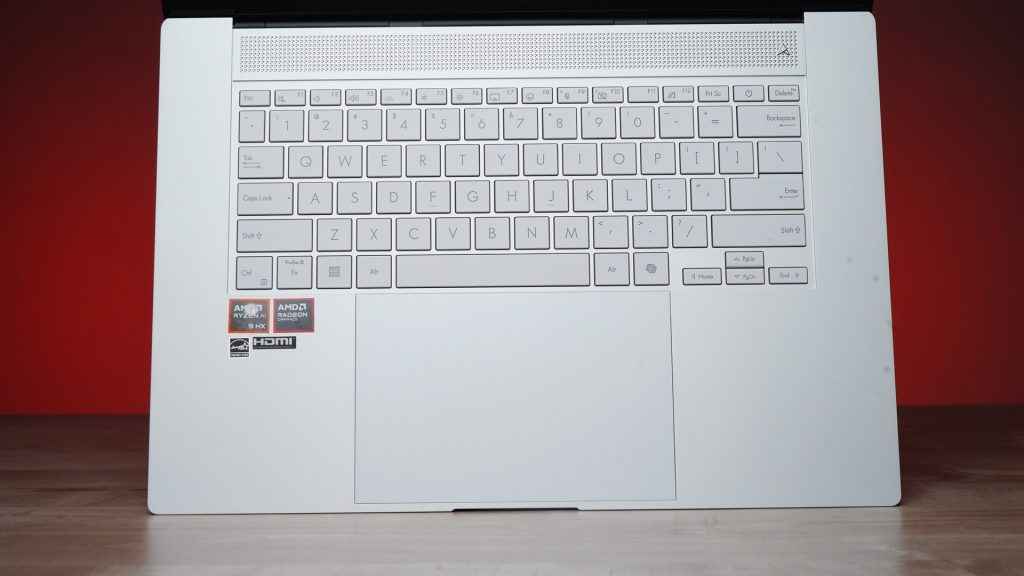
The all-metal body, complemented by the Ceraluminum touch on the lid, exudes a premium feel that’s hard to ignore. ASUS has done a tremendous job with the overall profile of the laptop, balancing a massive 16-inch display with a remarkably compact footprint and super-slim profile. The ultra-lightweight perfectly matches the laptop’s sleek design, making it a joy to carry around. What’s most impressive, however, is how the laptop’s design belies its beastly performance. This is no ordinary premium thin-and-light laptop; it’s a masterfully crafted package that combines performance, design, portability, and efficiency.
Display Performance:
The 16.0-inch, 3K (2880 x 1800) OLED display on the Asus Zenbook S 16 impresses with its color accuracy and overall performance. Our display tests confirmed that the Zenbook S 16 delivers on its promise of a 100% DCI-P3 color gamut. However, while Asus claims a peak brightness of 400 nits, our measurements revealed a maximum brightness of 314 nits when testing the display at multiple points (center and four corners). On a positive note, the touch response was excellent, and the inclusion of a stylus makes it a valuable addition.
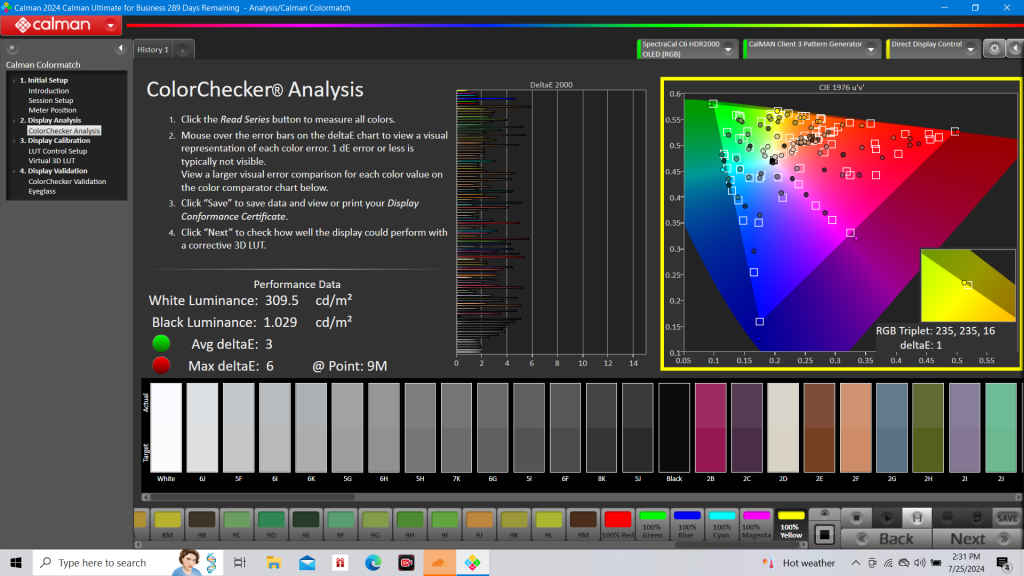
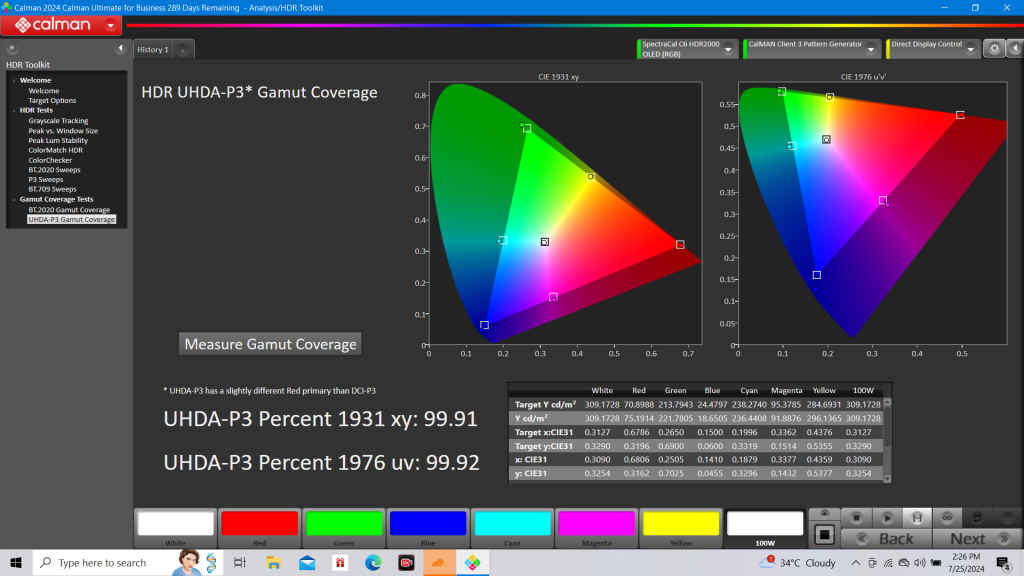

Final Thoughts:
The AMD Ryzen AI 300 series platform delivers exceptional performance and efficiency, making it a game-changer for productivity, graphics, and AI workloads. Paired with the Asus Zenbook S 16, it offers a powerful and portable solution for creators and professionals.
Note: This laptop has not yet been launched in India. We received the review unit from AMD India. AMD has indicated that this laptop will surely launch in India. The pricing given is indicative.
Also read: Asus Zenbook 14 OLED review
Soham Raninga
Soham Raninga is the Chief Editor for Digit.in. A proponent of performance > features. Soham's tryst with tech started way back in Dec 1997, when he almost destroyed his computer, trying to make the Quake II demo run at >30FPS View Full Profile
